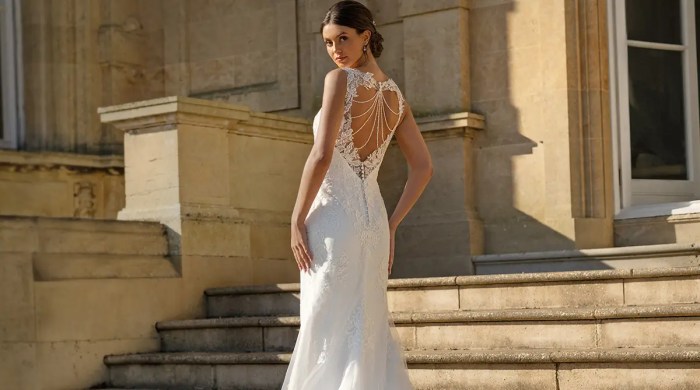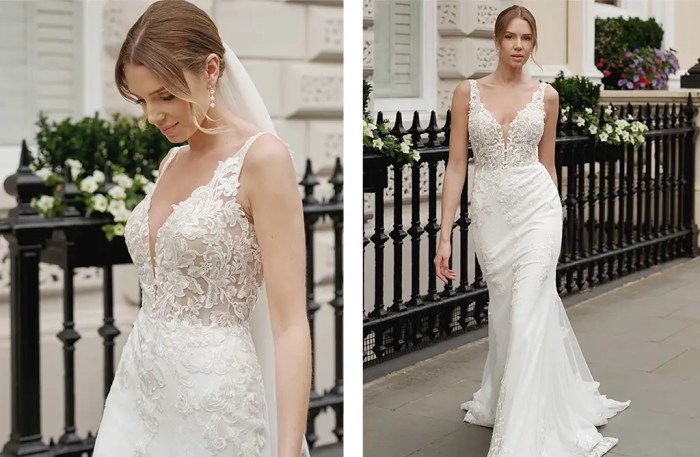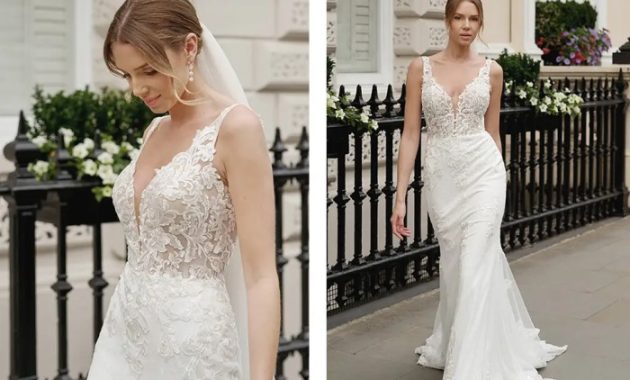Defining “Affordable” in Custom Wedding Dresses
Affordable custom wedding dresses – The term “affordable” is subjective when it comes to custom wedding dresses. It’s heavily influenced by individual budgets and expectations. This section clarifies the price range considered affordable, factors affecting this perception, and a comparison with ready-to-wear options.
Price Range and Influencing Factors
The price range for an affordable custom wedding dress can vary significantly. Generally, it can range from $1,000 to $5,000, but this can extend higher depending on the complexity and materials used. A simple A-line dress with minimal embellishments might fall within the lower end, while a more elaborate ballgown with intricate beading could reach the higher end. Geographic location plays a crucial role; prices in major cities are often higher than in smaller towns.
The bride’s overall budget, of course, is the most significant factor, influencing choices regarding fabric, embellishments, and design complexity.
Custom vs. Off-the-Rack: A Cost Comparison
Custom dresses generally cost more than off-the-rack options, but offer unparalleled personalization. The table below illustrates average price differences across various styles and materials.
| Dress Style | Off-the-Rack (Average) | Custom (Average) | Material |
|---|---|---|---|
| A-Line | $500 – $1500 | $1000 – $3000 | Tulle, Satin |
| Ballgown | $800 – $2500 | $1500 – $5000+ | Taffeta, Lace |
| Mermaid | $700 – $2000 | $1200 – $4000 | Lace, Crepe |
| Sheath | $400 – $1200 | $800 – $2500 | Silk, Satin |
Custom Design Options and Costs: Affordable Custom Wedding Dresses
Numerous elements contribute to the cost of a custom wedding dress. Understanding these factors allows brides to make informed choices while staying within their budget.
Customizable Elements and Cost Impact
- Fabric: The type of fabric (e.g., silk, lace, tulle) significantly impacts the cost. Silk and high-quality lace are more expensive than polyester or cheaper blends.
- Embellishments: Beading, embroidery, sequins, and other embellishments add to the cost, with hand-beaded designs being the most expensive.
- Silhouette: More complex silhouettes (e.g., ballgowns, mermaid styles) require more fabric and labor, increasing the cost.
- Details: Features like sleeves, trains, and intricate necklines also affect the overall price.
- Linings and Understructures: High-quality linings and understructures enhance the dress’s shape and durability, but add to the cost.
The Custom Dressmaking Process
- Initial Consultation: Discuss your vision, budget, and preferences with the designer.
- Design Development: The designer creates sketches and selects fabrics based on your input.
- Pattern Making and Muslin Fitting: A muslin mock-up is created and fitted to ensure a perfect fit.
- Fabric Selection and Ordering: Final fabric choices are made and ordered.
- Dress Construction: The designer constructs the dress.
- Final Fittings: Several fittings are conducted to ensure a perfect fit and address any necessary adjustments.
- Final Adjustments and Delivery: Final adjustments are made, and the completed dress is delivered.
Finding Affordable Custom Dressmakers
Finding a skilled and affordable custom dressmaker requires research and planning. Utilizing various resources can help you discover talented designers who fit your budget.
Resources and Dressmaker Types
| Resource | Description |
|---|---|
| Online Directories (Etsy, The Knot) | Browse profiles, view portfolios, and compare prices of various dressmakers. |
| Local Recommendations | Ask friends, family, or wedding planners for referrals to reputable dressmakers in your area. |
| Bridal Expos | Attend bridal expos to meet dressmakers in person and see their work. |
Independent designers often offer more competitive pricing than bridal boutiques, but boutiques might provide a more comprehensive service. Negotiating is possible with both.
Materials and Fabrics
Fabric selection significantly impacts both the aesthetic and cost of a custom wedding dress. Choosing wisely can help achieve an elegant look without breaking the bank.
Affordable and Elegant Fabrics, Affordable custom wedding dresses

Source: wed2b.com
Several fabrics offer a balance of affordability and elegance. Examples include crepe (known for its smooth drape and matte finish), chiffon (a lightweight, sheer fabric ideal for flowy designs), and charmeuse (a luxurious yet relatively affordable satin option). Lace, while potentially more expensive depending on the quality, can add a touch of elegance without necessarily being prohibitively costly.
Fabric Cost and Durability Comparison
| Fabric | Cost (Relative) | Durability | Suitable Styles |
|---|---|---|---|
| Polyester | Low | Moderate | A-line, sheath |
| Crepe | Moderate | High | Sheath, mermaid |
| Chiffon | Moderate | Moderate | A-line, ballgown |
| Lace | Variable | Moderate to High (depending on quality) | Most styles |
| Silk | High | High | Most styles |
Tips for Saving Money
Several strategies can help keep costs down during the custom dressmaking process. Careful planning and smart choices can significantly reduce expenses.
Cost-Saving Strategies
- Choose a simpler design: Avoid overly intricate designs or excessive embellishments.
- Use less embellishment: Strategically place embellishments rather than covering the entire dress.
- Select in-season fabrics: Fabrics in high demand may be more expensive.
- Consider DIY elements: Simple alterations or embellishments can be done yourself.
- Shop for affordable fabrics: Explore online fabric stores or local fabric shops for deals.
Budgeting for a Custom Dress
Create a realistic budget by estimating costs for materials, labor, and alterations. Include a contingency for unforeseen expenses. Tracking expenses throughout the process ensures you stay within your budget.
Illustrative Examples
Two example designs illustrate how to achieve affordable elegance with custom wedding dresses.
Simple, Elegant Design

Source: wed2b.com
A simple A-line dress made from crepe fabric would be an elegant and budget-friendly option. Minimal embellishments, perhaps delicate lace appliqués at the neckline, could add a touch of sophistication. This design minimizes fabric usage and construction complexity, keeping costs low.
More Elaborate, Yet Affordable Design
A ballgown silhouette in a high-quality chiffon, accented with strategically placed beading along the bodice, could offer a more elaborate look. Using less expensive fabric for the skirt and focusing embellishments on the upper body can balance cost and visual impact. Choosing a less intricate train or opting for a shorter train could also reduce costs.
Finding affordable custom wedding dresses can be surprisingly easy. Many designers offer bespoke options without the hefty price tag, allowing you to personalize your dream gown. For brides seeking a unique look, consider a stunning design like a white with black lace wedding dress , which offers a sophisticated contrast. Ultimately, affordable custom options provide the flexibility to create a truly individual and memorable wedding ensemble.
FAQ Insights
Can I alter an off-the-rack dress to make it more custom?
Yes, but significant alterations can sometimes cost almost as much as a simple custom dress. Consider the total cost before proceeding.
How far in advance should I start the custom dress process?
Ideally, begin 6-12 months before your wedding to allow ample time for design, fittings, and potential delays.
What happens if I need alterations after the dress is finished?
Most dressmakers include a final fitting and minor alterations. Significant changes after completion will usually incur additional costs.
What if I don’t have a clear vision for my dress?
Reputable designers will guide you through the process, offering inspiration and suggestions based on your style and budget.

